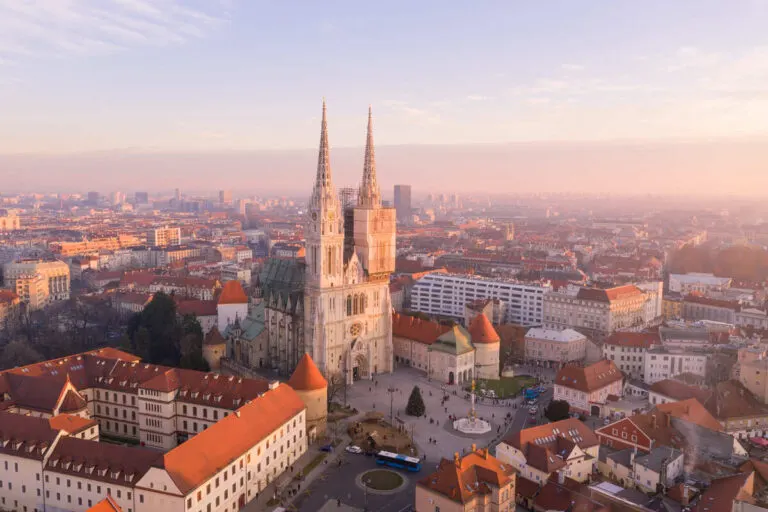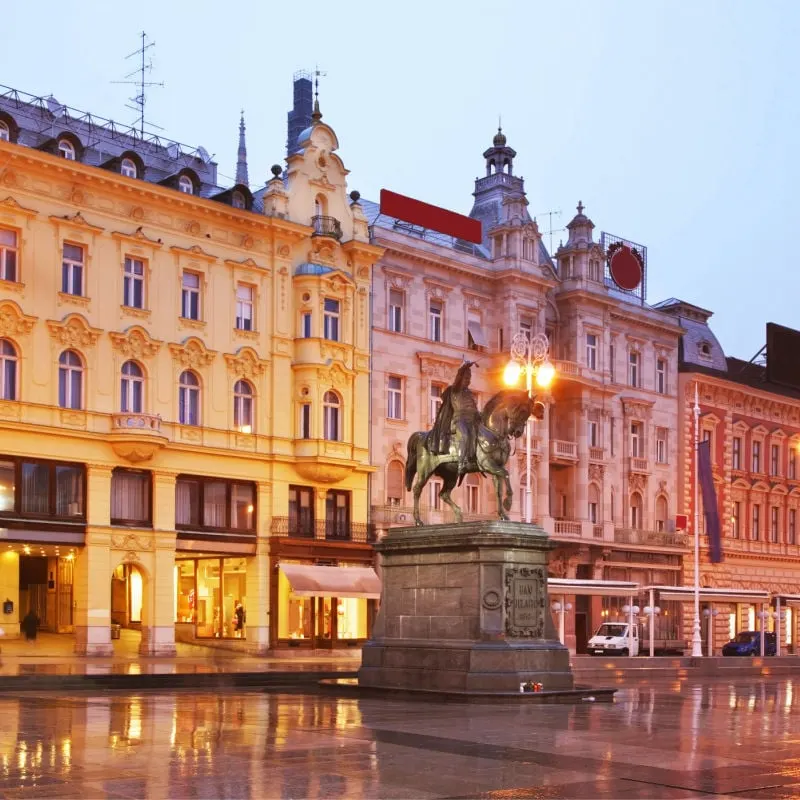Famous for its gorgeous coastline, ringed by a teal Adriatic Sea, its ancient cobbled towns dating back to times immemorial, and a balmy subtropical climate, Croatia is one of the most sought-after summer destinations in Europe this year.
While destinations like Dubrovnik and Split lead booking trends, however, thanks to their ancient culture and coastal location, it’s the Croatian capital of Zagreb, arguably its most vibrant city, that continues to be overlooked by most tourists.
But don’t pass it by! It’s perfect for those interested in history, unique cultural experiences, and vibrant city life, all on a budget.
It doesn’t have a beach, and it exists in a parallel universe to that of Roman-influenced Dalmatia, but it’s just as incredible, and it can be far cheaper to visit:
Why Is The Croatian Capital Of All Places One Of The Country’s Least-Visited Destinations?
National capitals are usually the most visited cities in a country: take Paris for instance, home to the Eiffel Tower and the monumental Louvre, or Rome, with its Colosseum and high concentration of monuments, or London and its landmark-packed Thames riverside.
They usually overshadow secondary destinations that have just as much to offer, yet short-term tourists won’t go out of their way to visit, like France’s castle-dotted Normandy, Northern Italy’s Verona, a ‘mini Rome’ of the sorts with its own Colosseum, or England’s summery Cornwall peninsula.

In Croatia’s case, the roles have been inverted: it’s the smaller Adriatic settlements, hundreds of miles away from the capital, that have taken the lead over the years, whether it’s pastel-colored Zadar, up-and-coming Split, or the storybook-fortified town of Dubrovnik.
Millions of foreigners fly into Croatia every summer, and though they will usually explore the coastline and its islands extensively, they’re bypassing the capital altogether, but here’s why they shouldn’t:
It Has Beautiful Architecture

One might struggle to believe that Zagreb and Dubrovnik are two cities under the same flag, as they couldn’t be further apart: while the Game of Thrones-featured, historic port is quintessentially Mediterranean, the former is indisputably Central European.
Zagreb traces its origins back to an 11th-century township, that would eventually be incorporated into the Austro-Hungarian Empire, hence its rich medieval heritage, and the elegant architecture that dominates much of the city center.

What we’re trying to say is don’t expect to find traditional Dalmatian ocher-stone houses with green shutters or narrow cobbled lanes; instead, you’ll be seeing grand boulevards lined by stately Habsburg buildings and an eclectic mix of Baroque Art Nouveau––and of course, Modernism.
Zagreb was once one of the largest cities in the former Yugoslavia, a socialist state that existed in Southeastern Europe for much of the 20th century, and its outskirts have their fair share of brutalist apartment blocks and concrete juggernauts.
This is an 800,000-people-strong metropolis, after all.
The city center, on the other hand, exists in the realm of cities like Budapest and Vienna, with the wide streets historic trams rattle through, verdant urban parks, and the odd palatial complex reminiscent of Zagreb’s imperial days.
The Old Town Is Incredibly Charming
The Old Town is divided between Lower and Upper parts: the Lower Town is centered around the twin-tower Zagreb Cathedral and a busy Ban Jelačić Square, flanked by shops and restaurants, while the Upper Town is like its own little picturesque village:

It is guarded by a medieval watchtower, accessible via one of the shortest funiculars in the world, traveling only 66 meters uphill, and all the narrow cobbled lanes seem to lead to the 13th-century St Mark’s Church, famous for its glazed-tile roof.
Dating back to World War II, Grič Tunnel is not to be missed, either: part of the city’s extensive system of underground passageways, it was once used by residents to reach the city center while keeping safe from shelling, but now houses occasional art exhibits.
If you want to see all the highlights without having to think you could always try a bike tour! It’s a great way to take it all in and under $50 per person, check it out here.
Among the endless amazing things you can get up to, there’s the Museum of Broken Relationships, in the heart of the Upper Town, a heart-wrenching exhibit of emotionally-charged objects linked to former lovers, be it a scarf, a teddy, or a family heirloom.
Zagreb museums are truly at a whole ‘nother level: whether it’s an 80s Museum hosting visitors in a nostalgic, six-room Yugoslav-era apartment or the equally quirky Museum of Hungovers, dedicated exclusively to absurd night-out stories, you’re in for some high-quality entertainment.
Epic Nightlife

Speaking of nightlife, Zagreb’s is probably the wildest, most unhinged in all of Croatia: for younger crowds and pumping techno music, Boogaloo is the place to go; for a more industrial, warehouse vibe, there’s the grimy Depo; for the gays, Rush Bar is all the fun you need on a Friday night.
Berlin still reigns unchallenged as the nightlife capital of Europe, but its overlooked Balkan counterpart might come at a close second, particularly when it comes to the edginess of its club scene and the thriving rave culture that’s developing.

If it’s a more laid-back experience you’re looking for, Tkalčićeva Street in the Old Town has a big selection of casual cocktail bars and restaurants, serving delicious $3 beer––there’s no way you’re leaving Zagreb without downing a pint of amber-colored Ožujsko––and $13 meals.
Zagreb Is More Affordable Than The Dalmatian Coast
Affordability is yet another big draw for the odd tourist willing to swap the Adriatic Coast for a city break in Zagreb: on average, they will spend $40 per day on food, from $44 upwards to $104 on hotels, and under $10 on local transportation, as based on estimates provided by Budget Your Trip.

Zagreb does not host your typical Mediterranean crowd, as it’s not, hem, Mediterranean, and as a result, room rates tend to be fairer: a bed in a shared dormitory costs as cheap as $21 this season, while a private, central Airbnb will set you back a moderate $63 per night.
Farther from the Old Town, the well-rated, three-star listing Tomislavov Dom costs $66 per night to book, while Hotel Croatia, in the Upper Town, within walking distance of St Mark’s Church and the Museum of Broken Relationships, is only $10 more expensive including breakfast.
How To Get To Zagreb This Summer

Despite being the Croatian capital, Zagreb does not host flights from the United States: it’s lost the status of a Transatlantic hub to Dubrovnik, where United Airlines has operated since 2021, offering flights to and fro Newark.
So while you can fly nonstop to Croatia this summer, you can only fly to Dubrovnik, at the very end of the Dalmatian Coast, a whole 375 miles south of Zagreb––thinking about it, it’s no wonder Americans bypass the capital altogether.
However, you can easily board a connecting flight to Zagreb from Dubrovnik with Croatia Airlines: there are multiple departures per day during summer, and one-way tickets on this route start from $63 at the cheapest fare (it normally does not include hold luggage). (check it out on Google Flights here)
Alternatively, you can fly instead from the States to a major European hub, such as Frankfurt, Paris or London, and connect onward to Zagreb from there: this will give you a wider range of airlines, like Lufthansa, AirFrance and British Airways, and potentially more attractive prices.
If you’re already in Central or Eastern Europe, Zagreb is easily reached by train or bus from:
- Ljubljana in Slovenia (1h44)
- Budapest in Hungary (3h39)
- Vienna in Austria (4h21)
- Belgrade in Serbia (4h)
Both Vienna and Belgrade host nonstop flights from the United States.
Credit: Source link




